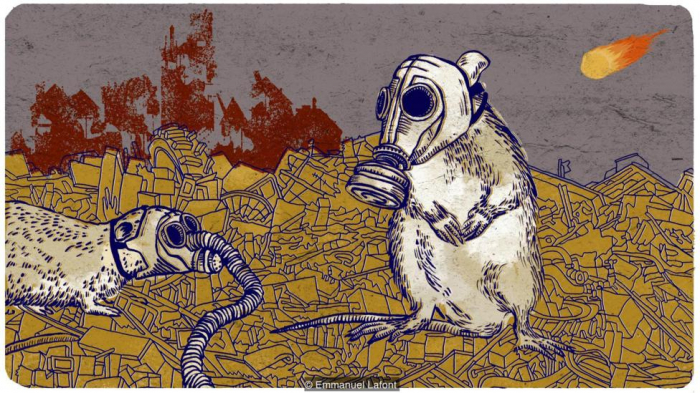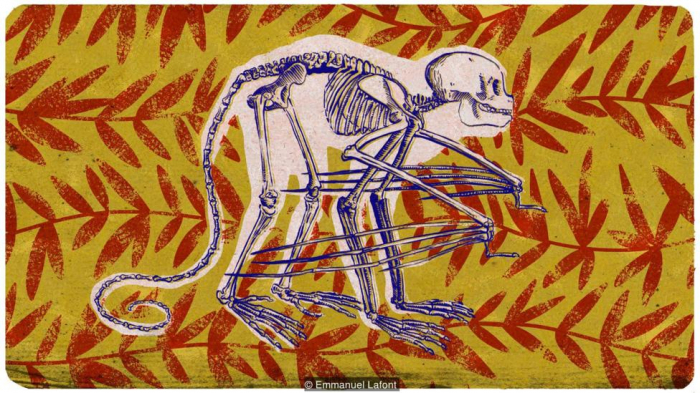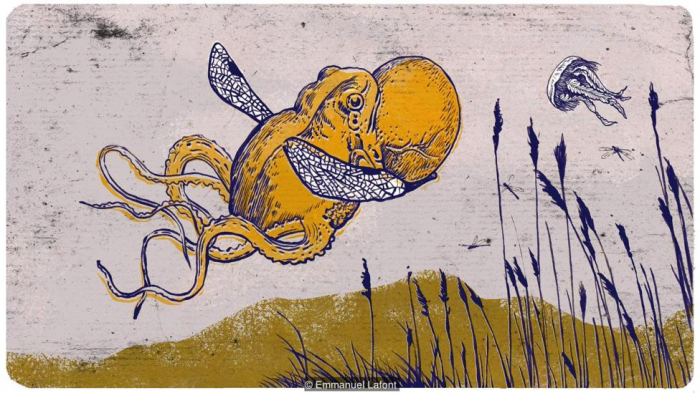In the early 1980s, the author Dougal Dixon published a cult book called After Man: A Zoology of the Future, which imagined what life would look like millions of years from now. Dixon envisaged shrews that use their tails as parachutes, flying monkeys (or “flunkeys”), super-long coiled snakes that strike out to snatch birds mid-flight, nightgliders that impale their prey with long spikes on their chests, and flower-faced birds and bats that fool pollinating insects into landing in their hungry mouths.
Decades later, Dixon says his book was not an attempt to predict the future, rather it was an exploration of all the possibilities of the natural world. “Popular-level books on evolution, even though it’s not intentional, seem to suggest evolution is something that happened in the past,” he says. “That’s not the case at all. Evolution is taking place today, it will continue to take place well into the future, long after we are gone.”
While Dixon’s book was a work of fiction, most biologists agree that millions of years from now Earth will be a very different place. “I think it’s gonna look and feel like an alien planet,” says Athena Aktipis, an evolutionary biologist at Arizona State University.
Whatever evolves will feel foreign and unlikely to us today – just as our current world, dominated by mammals, would have seemed improbable from the perspective of the dinosaur era. So, what might life look like in the future? What creatures could develop in, say, 100 million years, given what we know about life on Earth and the principles of evolution?
Let’s start by zooming back millions of years to a much earlier era of life on our planet. In the Cambrian explosion, some 540 million years ago, the Earth became populated by a whole host of “weirdo” and “cartoonish” creatures, according to Jonathan Losos, an evolutionary biologist at Washington University in St Louis.
“The Burgess Shale [in Canada] was inhabited by a veritable bestiary of the bizarre,” he writes in his book called Improbable Destinies: Fate, Chance, and the Future of Evolution. One animal, Hallucigenia, with its thin, tube-like body covered in rows of enormous spines, and stick-like clawed appendages was “similar to something out of a Futurama episode”.

Mimicking flowers: a new way for a bird to attract insects to eat? (Credit: Emmanuel Lafont)
So, it is not impossible for similarly weird and unusual creatures to evolve in future. “Just about anything plausible you can imagine has evolved somewhere at some point in some species,” Losos argues. “Given enough time, even the improbable will occur eventually.”
According to Losos, the world of biological possibilities is vast, and we may not have seen everything yet. “I, for one, am not at all convinced that life on Earth has uncovered every conceivable way of existing on a planet like our own, or even most of the ways,” he writes.
Still, it’s difficult to predict which of those possibilities we may end up with. Losos’ book analyses the arguments for and against the predictability of evolution: the question of whether history would repeat if we were to “replay the tape of life”. The evidence is split, and we simply don’t know to what extent evolution is predictable and repeatable over long time periods. Add to that an element of chance – a huge volcanic eruption or an asteroid hitting the Earth, and firm predictions become near impossible.
Yet, we can make educated guesses.
First, however, we must address the impact of a major evolutionary force that is already transforming life worldwide: Homo sapiens.
If humans thrive for millions of years, they will have a marked effect on future evolution, and natural selection will produce new varieties of life to deal with the altered, and probably polluted, environments that we create. “We may well see the evolution of a bird beak specialised for feeding out of tin cans, or rats developing oily fur to slough off toxic wastewater,” writes Peter Ward, a paleontologist at the University of Washington, Seattle, in his 2001 book Future Evolution.

Future animals may have to adapt to a more polluted world (Credit: Emmanuel Lafont)
Ward foresees opportunities for new types of species that possess “weedy” qualities – hardy, adaptable creatures that don’t mind living around humans and are able to make use of their world, such as house cats, rats, raccoons, coyotes, crows, pigeons, starlings, sparrows, flies, fleas, ticks, and intestinal parasites.
On a hotter, dryer Earth warmed by humans, a lack of fresh water may also prompt novel adaptations. “I would imagine animals that would evolve weird specialisations to capture moisture from the air,” says Patricia Brennan, an evolutionary biologist at Mount Holyoke College in Massachusetts. “Larger animals might evolve things like extended sails or skin flaps that they could extend out in the early morning to try to capture moisture. The frilly collars of some lizards, for example, could become very large and exaggerated to gather water in this way.”
In a hotter world, Brennan also envisages the rise of naked mammals and birds: “Mammals may lose fur in some patches and collect water in skin pockets. In a warming planet, endothermic animals [those that generate their own heat] may have a hard time, so birds in warmer climates may lose contour feathers to prevent overheating, and mammals may lose most fur.”
Future humans may also decide to directly manipulate life – in fact, it’s happening already. As the researcher Lauren Holt wrote for BBC Future’s Deep Civilisation series earlier this year, one trajectory for life on Earth could be a “post-natural” one. In this scenario, genetic engineering, biotechnology and the influence of human culture could redirect evolution down radically different paths, from mosquitoes that contain gene drives to mechanical pollinator drones. The evolution of life would be entwined with humanity’s own desires and needs.

The antlers of a deer could one day take on a new purpose (Credit: Emmanuel Lafont)
However, there are alternative paths for future evolution: for example, our more enlightened descendants may decide to rewild nature and let natural evolution pursue its course, or humans could become extinct (which was the scenario of After Man).
Extinction in particular can lead to sweeping evolutionary innovation. In essence, a mass extinction resets the evolutionary clock, argues Ward. After previous mass extinctions, he says, Earth’s plants and animals changed radically.
The Permian extinction, around 252 million years ago, eliminated over 95% of marine and 70% of land species, including fin-backed reptiles and massive mammal-like reptiles that ruled the Earth at the time. It made space for dinosaurs to evolve and take over as the dominant land animals, an outcome perhaps as unlikely and unexpected as the take-over by mammals when they replaced dinosaurs after the Cretaceous-Tertiary mass extinction.
“There was not only a turnover, but also what we might call a ‘changeover’,” Ward writes. “Mass extinctions did more than just change the number of species on Earth. They also changed the makeup of the Earth.”
Following an extinction, some biologists think it’s possible that whole new lifeforms with new capabilities will evolve; so different that we can’t even imagine what they might be like. For the first billion years or so of life on Earth, for example, oxygen-breathing animals would have been inconceivable, because oxygen was in short supply and cells hadn’t evolved to use it for energy. That changed forever with the Great Oxidation Event, around 2.4 billion years ago, when the arrival of photosynthesising bacteria led to the Earth’s first mass extinction.
“The microbes caused the whole planet to have oxygen and that created a huge shift,” says Leonora Bittelston, an evolutionary biologist at the Massachusetts Institute of Technology. “There have been a lot of innovations that could have been hard to predict before they happened – but once they start happening, they do change our planet.”

With enough time, strange and unprecedented combinations are not impossible (Credit: Emmanuel Lafont)
So, if humans die off, how wild and sophisticated could things get 100 million years from now? Could we see trees starting to walk, or feasting on animals after killing them with toxic fumes or poisonous darts? Could sea life change, with spiders taking to the water, using their webs to net sardines, while fish learn to fly so they can feed on insects and birds? Could deep-sea animals project bright holograms of themselves to fool predators, attract prey or impress potential mates? Perhaps killer whales and catfish will regain their ancestors’ past ability to run on land so that they can hunt more effectively onshore?
If humans die off, how wild and sophisticated could things get?
Could we also see organisms take up residence in previously underexplored habitats: for example, giant, lightweight poisonous fungi floating in mid-air like an aerial jellyfish, entangling and consuming anything they bump into? Or could insects and spiders build silk nests in the clouds and feed on photosynthesising organisms in the sky? And if plants or microbes evolved something like solar panels to track and concentrate sunlight, could green oases of life thrive on frigid glaciers?
None of these fantastical creatures sound impossible, says Aktipis. A lot of them are based on what already exists in nature: there are seafaring and gliding spiders, there is microbial life in the clouds, and deep sea anglerfish dangle bioluminescent balls in front of them to attract prey. Some populations of killer whales and catfish can beach to hunt for animals on the shoreline, and small independent oases of life thrive on ice where there are residues of cryoconite, a black dust made up of soot, rock and microbes.
Jo Wolfe, an evolutionary biologist at Harvard University, notes that some trees are able to “walk” very slowly as they move towards sources of water, and thinks it’s possible that trees could evolve to hunt using poisonous gases or even spiked branches. After all, we already have carnivorous plants like the Venus flytrap. She also points to the existence of spiders that eat fish, and says that cloud-dwelling microbes could possibly evolve from the multitude of tiny organisms known as Prochlorococcus that live in the uppermost layers of the ocean.

Current tree-dwellers may adapt to the air in the far future (Credit: Emmanuel Lafont)
In nature, often all it takes for unusual adaptations to develop are extreme environments. Earth already has plenty of those, and that is not going to change. For example, consider how the male anglerfish has responded to the dire shortage of potential mates in the deep ocean. When he meets a female, he actually fuses into her body. “It is so unlikely he'll ever meet another female again that he just gives up and becomes a sperm accessory for her,” says Kristin Hook, a behavioural ecologist at the University of Maryland, College Park. “So, we might see animals doing more things like this, and over time I'd imagine selection favouring animals that can self-fertilise when finding mates is nearly impossible.”
Based on what we know of nature, we also shouldn’t assume that future creatures will stay confined to their current habitats. Lynn Caporale, a biochemist and author, points out that some “flying” fish can already catch insects (and even birds), and some fish are able to walk on land, even climb trees. Even squid occasionally fly above the ocean surface, using squirts of water as propulsion and fins that double as wings.
This potential for habitat-switching leads to some pretty fantastical possibilities. Consider a toad whose gullet swells outward as a large gasbag used to make mating calls. In his book, Ward playfully envisages it evolving into a “zeppelinoid”, a new type of floating animal that will conquer the lower atmosphere. The toad could evolve to make hydrogen out of water and store it in its throat, helping it to hop and eventually float in the air. Its legs – no longer needed for walking – could become dangling tentacles used for feeding and it would evolve to be large to avoid being eaten – maybe even larger than a blue whale. Giant zeppelinoids would float in the air like jellyfish, dragging their tentacles to catch prey such as deer, and grazing on treetops. They would fill the skies and their shifting shadows would dominate the landscape – the age of the flying toad.
Zeppelinoids, says Ward, are “a fairy tale – but there is a glimmer of reality in this fable”. There was once the first flying organism and the first swimming organism, and we know that more species quickly evolved from them, as the innovation allowed them to take over a habitat they never had access to before.

Could toads float through the air, becoming 'zeppelinoids'? (Credit: Emmanuel Lafont)
Given that our understanding of evolution and genetics is incomplete, and that much will likely depend on chance events, no one can know for sure what future life will look like. Picking the evolutionary winners of the future is like trying to pick winners on the stock market, or forecasting the weather, writes Ward. We have some data for making educated guesses, but also a large degree of uncertainty. “The colours, habits, and shapes of the newly evolved fauna can only be guessed at.”
Losos agrees. “At the end of the day,” he says, “the possibilities are so wide and uncertain that it’s really pointless trying to speculate about what life might look like – there are just way too many degrees of freedom. Life could go in so many different ways.”
But if the weirdness of present-day life is a guide, we should not discount the possibility that future evolution could go down some truly mind-boggling paths. And a great deal of current natural creativity and diversity remains unexplored.
Indeed, Dixon notes that several of the original “purely speculative” creations he described in his After Man book in 1981 were subsequently discovered: for example, walking bats and snakes that can snatch bats from the air. As he reflected in the 2018 edition of the book: “Many’s the time that I have come across some new ecological or evolutionary development and thought, ‘If I had put that in After Man everyone would have laughed’.”
BBC
More about: earth
















































